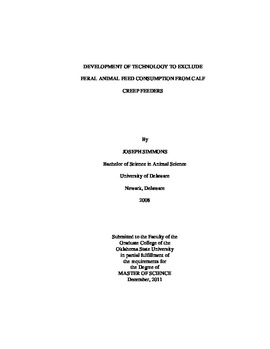| dc.description.abstract | A series of experiments was performed with the objective of creating a system to exclude feral animals from calf creep feeders. The first experiment evaluated three different electronic sensor systems for accuracy of identifying calves attending a mobile creep feeder. Efficacy of sensor placement for active RFID rumen technologies was evaluated. Fifty seven post-weaning calves were stratified by weight and randomly assigned by to three pastures, each containing a single creep feeder outfitted with one of several combinations of electronic sensor technologies. All calves were also administered an active RFID rumen bolus. Creep feeders 1 and 3 were equipped with three active RFID readers, one on the left side of the feeder, one on the right, and one suspended on a post on the center of the feeder. Creep feeder 2 was equipped with the same configuration of active RFID readers, as well as one directional RFID reader, and one large size passive RFID panel reader. Each feeder was also equipped with ultrasonic sensor systems, although due to equipment failures these systems did not produce any results. Active RFID data was collected for 25 d, passive RFID data was collected for 4 d, and video cameras recorded the same 4 d, for evaluation of accuracy of active and passive data. This data was analyzed to find accuracy of passive RFID sensor technology, maximum gap in receptions for each active RFID sensor configuration, and also to determine any general improvements to each system. It was determined that the passive RFID system was able to detect 87% of calf entries into the feeder. It was also found that the average of the highest amount of time between active RFID message receptions between all receivers was 0:07:140:06:47 (h:mm:ss) during a congregation where calves were physically present at the feeder. Data from this study suggests that active RFID bolus transmitters may be suitable for identification of calf attendance at creep feeding sites. The second experiment evaluated electronic controlled systems for exclusion of feral animals from cattle creep feeders. Forty-five suckling calves were bolused with active rumen bolus RFID transmitters, stratified by weight and randomly assigned to three pastures. Feeder design treatments consisted of a back opening door design, an up opening door design, and a completely open control feeder evaluated in a 3x3 Latin square treatment structure. Calves were adapted to the creep feeders during a 23 d adaptation period during which calves had access to all 3 creep feeder designs, followed by three 21 d periods during which the creep feeders were rotated between pastures. Parameters measured included feed disappearance. The back and up opening feeders were fitted with RFID receivers and data storage devices. This data was used to evaluate calf attendance parameters between the two door designs over each 21 d period. Additionally, 24 hr of video data from every feeder each period was used to compare attendance paramaters between all three feeder designs. A significant feed disappearance effect due to type of feeder was found (P=0.13) with the control feeder having the highest rate of disappearance, and the back and up treatment feeders having lower and statistically similar amounts of disappearance (P=0.94). It was found that the up opening door design was most successful at excluding feral animals, and also the most reliable. It was also found that the completely open control design had the highest rate of feed disappearance. | |
